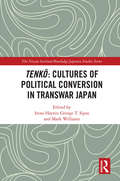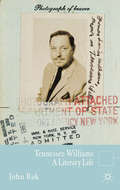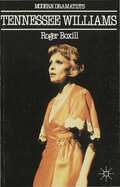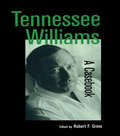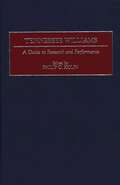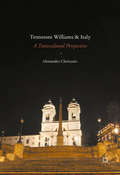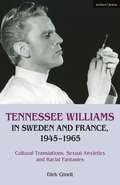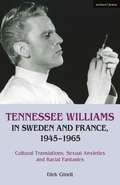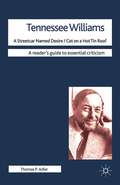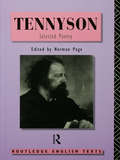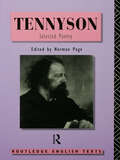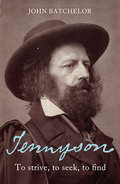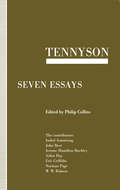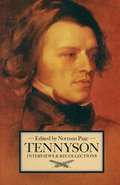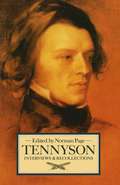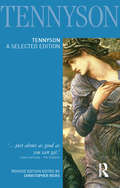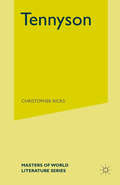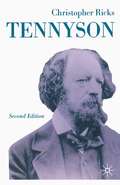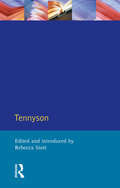- Table View
- List View
Tenet
by Christopher NolanTenet is a global thriller whose action stretches across time zones, and stars Robert Pattinson, Elizabeth Debicki and John David Washington. The film displays Nolan's preoccupations, especially how Time can shift from on moment to the next,The fact that the title - TENET - can be read forwards and backwards indicates the complexity of the film
Tenkō: Cultures of Political Conversion in Transwar Japan (Nissan Institute/Routledge Japanese Studies)
by Irena Hayter George T. Sipos Mark WilliamsThis book approaches the concept of tenkō (political conversion) as a response to the global crisis of interwar modernity, as opposed to a distinctly Japanese experience in postwar debates. Tenkō connotes the expressions of ideological conversion performed by members of the Japanese Communist Party, starting in 1933, whereby they renounced Marxism and expressed support for Japan’s imperial expansion on the continent. Although tenkō has a significant presence in Japan’s postwar intellectual and literary histories, this contributed volume is one of the first in Englishm language scholarship to approach the phenomenon. International perspectives from both established and early career scholars show tenkō as inseparable from the global politics of empire, deeply marked by an age of mechanical reproduction, mediatization and the manipulation of language. Chapters draw on a wide range of interdisciplinary methodologies, from political theory and intellectual history to literary studies. In this way, tenkō is explored through new conceptual and analytical frameworks, including questions of gender and the role of affect in politics, implications that render the phenomenon distinctly relevant to the contemporary moment. Tenkō: Cultures of Political Conversion in Transwar Japan will prove a valuable resource to students and scholars of Japanese and East Asian history, literature and politics.
Tenkō: Cultures of Political Conversion in Transwar Japan (Nissan Institute/Routledge Japanese Studies)
by Irena Hayter; George T. Sipos; Mark WilliamsThis book approaches the concept of tenkō (political conversion) as a response to the global crisis of interwar modernity, as opposed to a distinctly Japanese experience in postwar debates. Tenkō connotes the expressions of ideological conversion performed by members of the Japanese Communist Party, starting in 1933, whereby they renounced Marxism and expressed support for Japan’s imperial expansion on the continent. Although tenkō has a significant presence in Japan’s postwar intellectual and literary histories, this contributed volume is one of the first in Englishm language scholarship to approach the phenomenon. International perspectives from both established and early career scholars show tenkō as inseparable from the global politics of empire, deeply marked by an age of mechanical reproduction, mediatization and the manipulation of language. Chapters draw on a wide range of interdisciplinary methodologies, from political theory and intellectual history to literary studies. In this way, tenkō is explored through new conceptual and analytical frameworks, including questions of gender and the role of affect in politics, implications that render the phenomenon distinctly relevant to the contemporary moment. Tenkō: Cultures of Political Conversion in Transwar Japan will prove a valuable resource to students and scholars of Japanese and East Asian history, literature and politics.
Tennessee Williams: A Literary Life (Literary Lives #Vol. 54)
by J. BakThis Literary Life draws extensively from the playwright's correspondences, notebooks, and archival papers to offer an original angle to the discussion of Williams's life and work, and the times and circumstances that helped produce it.
Tennessee Williams (Modern Dramatists)
by Caroline Fehl'...Boxill... writes with the same sympathy and grace as his writer under scrutiny.' Plays and Players.
Tennessee Williams: A Casebook
by Robert GrossTennessee Williams' plays are performed around the world, and are staples of the standard American repertory. His famous portrayals of women engage feminist critics, and as America's leading gay playwright from the repressive postwar period, through Stonewall, to the growth of gay liberation, he represents an important and controversial figure for queer theorists. Gross and his contributors have included all of his plays, a chronology, introduction and bibliography.
Tennessee Williams: A Casebook
by Robert F. GrossTennessee Williams' plays are performed around the world, and are staples of the standard American repertory. His famous portrayals of women engage feminist critics, and as America's leading gay playwright from the repressive postwar period, through Stonewall, to the growth of gay liberation, he represents an important and controversial figure for queer theorists. Gross and his contributors have included all of his plays, a chronology, introduction and bibliography.
Tennessee Williams: A Guide to Research and Performance (Non-ser.)
by Prof. Philip KolinThe plays of Tennessee Williams are some of the greatest triumphs of the American theatre. If Williams is not the most important American playwright, he surely is one of the two or three most celebrated, rivaled only by Eugene O'Neill and Arthur Miller. In a career that spanned almost five decades, he created an extensive canon of more than 70 plays. His contributions to the American theatre are inestimable and revolutionary. The Glass Menagerie (1945) introduced poetic realism to the American stage; A Streetcar Named Desire (1947) explored sexual and psychological issues that had never before been portrayed in American culture; Cat on a Hot Tin Roof (1955) dared to challenge the political and sexual mores of the Eisenhower era; and his plays of the 1970s are among the most innovative works produced on the American stage. But Williams was far more than a gifted and prolific playwright. He created two collections of poetry, two novels, four collections of stories, memoirs, and scores of essays.Because of his towering presence in American drama, Williams has attracted the attention of some of the most insightful scholars and critics of the twentieth century. The 1990s in particular ushered in a renaissance of Williams research, including a definitive biography, a descriptive bibliography, and numerous books and scholarly articles. This reference book synthesizes the vast body of research on Tennessee Williams and offers a performance history of his works. Under the guidance of one of the leading authorities on Williams, expert contributors have written chapters on each of Williams' works or clusters of works. Each chapter includes a discussion of the biographical context of a work or group of writings; a survey of the bibliographic history; an analysis of major critical approaches, which looks at themes, characters, symbols, and plots; a consideration of the major critical problems posed by the work; an overview of chief productions and film and television versions; a concluding interpretation; and a bibliography of secondary sources. The volume concludes with a selected, general bibliography and a comprehensive index.
Tennessee Williams and Italy: A Transcultural Perspective
by Alessandro ClericuzioThis book reveals for the first time the import of a huge network of connections between Tennessee Williams and the country closest to his heart, Italy. America's most thought-provoking playwright loved Italy more than any other country outside the US and was deeply influenced by its culture for most of his life. Anna Magnani's film roles in the 1940s, Italian Neo-realist cinema, the theatre of Eduardo De Filippo, as well as the actual experience of Italian life and culture during his long stays in the country were some of the elements shaping his literary output. Through his lover Frank Merlo, he also had first-hand knowledge of Italian-American life in Brooklyn. Tracing the establishment of his reputation with the Italian intelligentsia, as well as with theatre practitioners and with generations of audiences, the book also tells the story of a momentous collaboration in the theatre, between Williams and Luchino Visconti, who had to defy the unceasing control Italian censorship exerted on Williams for decades.
Tennessee Williams in Sweden and France, 1945–1965: Cultural Translations, Sexual Anxieties and Racial Fantasies
by Dirk GindtThe immediate post-war period marks a pivotal moment in the internationalization of American theatre when Tennessee Williams' plays became some of Broadway's most critically acclaimed and financially lucrative exports. Dirk Gindt offers a detailed study of the production and reception of Williams' work on Swedish and French stages at the height of his popularity between 1945 and 1965. Analysing the national openings of seminal plays, including The Glass Menagerie, A Streetcar Named Desire, Cat on a Hot Tin Roof, Orpheus Descending and Suddenly Last Summer, Gindt provides rich and nuanced insights into Williams' transnational impact. In the process, he charts a network of fascinating and influential directors, actors, designers, producers and critics, all of whom left distinctive marks on mid-twentieth-century European theatre and culture. Gindt further demonstrates how Williams' work foregrounded cultural apprehensions, racial fantasies and sexual anxieties, which resulted in heated debates in the critical and popular media.
Tennessee Williams in Sweden and France, 1945–1965: Cultural Translations, Sexual Anxieties and Racial Fantasies
by Dirk GindtThe immediate post-war period marks a pivotal moment in the internationalization of American theatre when Tennessee Williams' plays became some of Broadway's most critically acclaimed and financially lucrative exports. Dirk Gindt offers a detailed study of the production and reception of Williams' work on Swedish and French stages at the height of his popularity between 1945 and 1965. Analysing the national openings of seminal plays, including The Glass Menagerie, A Streetcar Named Desire, Cat on a Hot Tin Roof, Orpheus Descending and Suddenly Last Summer, Gindt provides rich and nuanced insights into Williams' transnational impact. In the process, he charts a network of fascinating and influential directors, actors, designers, producers and critics, all of whom left distinctive marks on mid-twentieth-century European theatre and culture. Gindt further demonstrates how Williams' work foregrounded cultural apprehensions, racial fantasies and sexual anxieties, which resulted in heated debates in the critical and popular media.
Tennessee Williams - A Streetcar Named Desire/Cat on a Hot Tin Roof (Readers' Guides to Essential Criticism)
by Thomas AdlerA Streetcar Named Desire (1947) and Cat on a Hot Tin Roof (1955) are major plays by Tennessee Williams, one of America's most significant dramatists. They both received landmark productions and are widely-studied and performed around the world. The plays have also inspired popular screen adaptations and have generated a body of important and lasting scholarship.In this indispensable Reader's Guide, Thomas P. Adler:• charts the development of the criticism surrounding both works, from the mid-twentieth century through to the present day• provides a readable assessment of the key debates and issues• examines a range of theoretical approaches from biographical and New Criticism to feminist and queer theory.In so doing, Adler helps us to appreciate why these plays continue to fascinate readers, theatregoers and directors alike.
Tennessee Williams - A Streetcar Named Desire/Cat on a Hot Tin Roof (Readers' Guides to Essential Criticism)
by Thomas AdlerA Streetcar Named Desire (1947) and Cat on a Hot Tin Roof (1955) are major plays by Tennessee Williams, one of America's most significant dramatists. They both received landmark productions and are widely-studied and performed around the world. The plays have also inspired popular screen adaptations and have generated a body of important and lasting scholarship.In this indispensable Reader's Guide, Thomas P. Adler:- Charts the development of the criticism surrounding both works, from the mid-twentieth century through to the present day- Provides a readable assessment of the key debates and issues- Examines a range of theoretical approaches from biographical and New Criticism to feminist and queer theoryIn so doing, Adler helps us to appreciate why these plays continue to fascinate readers, theatregoers and directors alike.
Tennyson: Selected Poetry
by Lord Tennyson Alfred Professor Norman Page Norman PageRepresents Tennyson's work in many poetic forms over more than sixty years. The collection includes a substantial introduction, explanatory notes and bibliographical information.
Tennyson: Selected Poetry
by Lord Tennyson Alfred Professor Norman Page Norman PageRepresents Tennyson's work in many poetic forms over more than sixty years. The collection includes a substantial introduction, explanatory notes and bibliographical information.
Tennyson: To Strive, to Seek, to Find
by John BatchelorAlfred Lord Tennyson, Queen Victoria’s favourite poet, commanded a wider readership than any other of his time. His ascendancy was neither the triumph of pure genius nor an accident of history:he skilfully crafted his own career and his relationships with his audience. Fame and recognition came, lavishly and in abundance, but the hunger for more never left him. Like many successful Victorians, he was a provincial determined to make good in the capital while retaining his regional strengths. One of eleven children, he remained close to his extended family and never lost his Lincolnshire accent.Resolving never to be anything except ‘a poet’, he wore his hair long, smoked incessantly and sported a cloak and wide-brimmed Spanish hat.Tennyson ranged widely in his poetry, turning his interests in geology, evolution and Arthurian legend into verse, but much of his workrelates to his personal life. The tragic loss of Arthur Hallam, a brilliant friend and fellow Apostle at Cambridge, fed into some of his most successful and best-known poems. It took Tennyson seventeen years to complete his great elegy for Hallam, In Memoriam, a work which established his fame and secured his appointment as Poet Laureate.The poet who wrote The Lady of Shalott and The Charge of the Light Brigade has become a permanent part of our culture. This enjoyable and thoughtful new biography shows him as a Romantic as well as a Victorian, exploring both the poems and Tennyson’s attempts at play writing, as well as the pressures of his age and the personal relationships that made the man.
Tennyson: Seven Essays
by Philip CollinsThese essays are lectures, mostly revised or expanded, given to the Tennyson Society by leading Victorianists, including one of the doyens of Tennyson studies, Jerome H. Buckley (Harvard). In Memoriam and Maud are central texts but many other poems are discussed - lyrics, dramatic monologues, narratives, ballads - and such recurrent topics as loss, the numinous, and distance in space and time. The poems are related to their intellectual context and to other poets from Wordsworth to Edward FitzGerald.
Tennyson: A Selected Edition
by Christopher RicksThis is the only fully annotated and comprehensive selection of Tennyson’s poetry. Acknowledged as a major achievement of editorial scholarship, it has established itself as the standard edition of Tennyson. The collection contains in full all four of Tennyson's long poems: The Princess, In Memoriam, Maud, and Idylls of the King. Other key works are included from Mariana, The Lady of Shallott, Morte d'Arthur, Ulysses, and Tithonus through Tennyson's middle life and the Ode on the Death of the Duke of Wellington, to his last years and Crossing the Bar.
Tennyson: A Selected Edition
by Christopher RicksThis is the only fully annotated and comprehensive selection of Tennyson’s poetry. Acknowledged as a major achievement of editorial scholarship, it has established itself as the standard edition of Tennyson. The collection contains in full all four of Tennyson's long poems: The Princess, In Memoriam, Maud, and Idylls of the King. Other key works are included from Mariana, The Lady of Shallott, Morte d'Arthur, Ulysses, and Tithonus through Tennyson's middle life and the Ode on the Death of the Duke of Wellington, to his last years and Crossing the Bar.
Tennyson
by Christopher RicksThis biographical and critical study of Tennyson has a threefold purpose: to show what went to the making of Tennyson the man; to establish the power, subtlety and variety of his poems, along with the artistic principles and preoccupations which shaped his life's work; and to suggest the relationships between the man and the poet.
Tennyson
by Christopher RicksA biographical and critical study of Tennyson aiming to show what went into the making of the man, exploring the power, subtlety and variety of his poems, along with the artistic principles and preoccupations which shaped his life's work.
Tennyson
by Rebecca StottAlternative approaches have emerged which have radically altered our understanding of Tennyson's poetry and his relationship to the Victorian age. This text covers the most significant areas of new work on Tennyson, effectively linking feminist and gender studies with deconstructive, psychoanalytic and linguistic attention. The Introduction discusses ways in which orthodox critical approaches have dominated readings of Tennyson's poetry and provides a critical overview of the radical reappraisal of his work. It also provides a guide to the varied ways in which these new debates have shaped and are shaping themselves, with a final discussion of the future directions which Tennyson criticism is likely to take. The essays chosen cover and reflect a range of modes of critical enquiry compelling in themselves.
Tennyson
by Rebecca StottAlternative approaches have emerged which have radically altered our understanding of Tennyson's poetry and his relationship to the Victorian age. This text covers the most significant areas of new work on Tennyson, effectively linking feminist and gender studies with deconstructive, psychoanalytic and linguistic attention. The Introduction discusses ways in which orthodox critical approaches have dominated readings of Tennyson's poetry and provides a critical overview of the radical reappraisal of his work. It also provides a guide to the varied ways in which these new debates have shaped and are shaping themselves, with a final discussion of the future directions which Tennyson criticism is likely to take. The essays chosen cover and reflect a range of modes of critical enquiry compelling in themselves.

